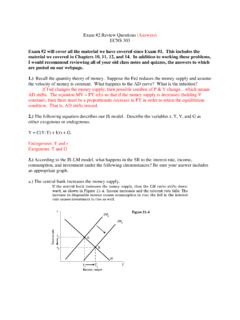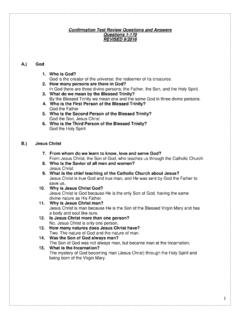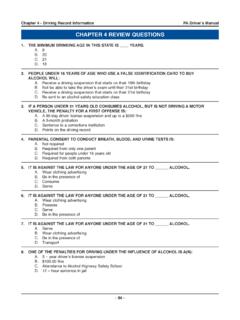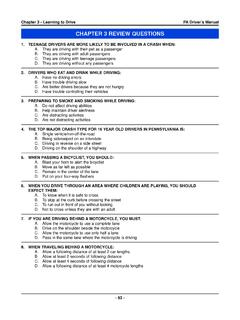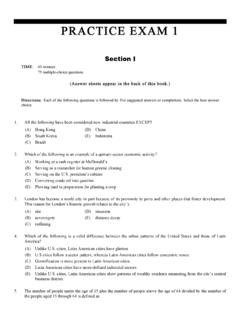Transcription of Chemistry 51 ASNWER KEY REVIEW QUESTIONS
1 Chemistry 51 ASNWER KEY. REVIEW QUESTIONS . Chapter 6. 1. Classify the type of each of the following reactions: a) (NH4)2SO4 2 NH3 + SO2 + H2 decomposition b) Br2 + 2 KI 2 KBr + I2 single replacement c) 2 Na + Cl2 2 NaCl synthesis d) Al(OH)3 + 3 HCl AlCl3 + 3 H2O double replacement 2. Balance each of the equations shown below: a) 5 C + 2 SO2 1 CS2 + 4 CO. b) 2 Na3N 6 Na + 1 N2. c) 1 C3H8 + 5 O2 3 CO2 + 4 H2O. d) 2 Al + 3 H2SO4 1 Al2(SO4)3 + 3 H2. 3. Predict the products for each reaction and balance the equation. If no reaction occurs, write No Reaction after the arrow: a) 2 Al (s) + 6 HCl (aq) 2 AlCl3 (aq) + 3 H2 (g). b) 3 Mg (s) + 2 FeCl3 (aq) 3 MgCl2 (aq) + 2 Fe (s). c) 1 F2 (g) + 2 KCl (aq) 2 KF (aq) + Cl2 (g). d) Cu (s) + Ca(NO3)2 No Reaction (Ca is more reactive than Cu). e) 1 Pb (s) + 2 AgNO3 (aq) Pb(NO3)2 (aq) + 2 Ag (s). 1. 4. Identify each reaction below as oxidation or reduction: a) Pb Pb2+ + 2 e oxidation (loss of electrons).
2 B) C2H2 + H2 C2H4 reduction (gain of hydrogen). c) Cr3+ + 3 e Cr reduction (gain of electrons). d) C2H5OH C2H4O + H2 oxidation (loss of hydrogen). 5. In the following reactions, identify which reactant is oxidized and which is reduced: a) 2 Li (s) + F2 (g) 2 LiF (s). oxidized: Li reduced: F2. b) Cl2 (g) + 2 KI (aq) 2 KCl (aq) + I2 (g). oxidized: I reduced: Cl2. c) Zn (s) + CuSO4 (aq) ZnSO4 (aq) + Cu (s). oxidized: Zn reduced: Cu2+. d) 2 PbO (s) 2 Pb (s) + O2 (g). oxidized: O2 reduced: Pb2+. 2. 6. Calculate each of the following quantities: a) Number of moles in 112 g of aspirin, C9H8O4. Molar mass = [9( )+8( )+4( )] = g/mol 1 mol Moles = 112 g x = mol (3 sig figs). g b) Mass of moles of silver acetate, AgC2H3O2. Molar mass = [ + 2( )+3( )+2( )] = g/mol g Mass = mol x = 638 g (3 sig figs). 1 mol c) Number of molecules in moles of CO2. Molar mass = +2( ) = g/mol # of CO2 molecules = mol CO x = (3 sig figs).
3 2 1 mol d) Number of mole of H atoms in g of CH4. Molar mass = + 4( )= g/mol 1 mol 4 mo H atoms # of CH4 molecules = g CH 4 x x = mol H atoms (3 sig figs). g 1 mol CH 4. 3. 7. Use the equation below to determine the mole ratios below: 2 CH4 + 3 O2 + 2 NH3 2 HCN + 6 H2O. mol NH 3 2 1 mol H 2 O 6. A) = = C) = =3. mol H 2 O 6 3 mol CH 4 2. mol HCN 2 mol O2 3 1. B) = D) = =. mol O2 3 mol H 2O 6 2. Use the reaction shown below to answer the next 3 QUESTIONS : 2 C2H6 (g) + 7 O2 (g) 4 CO2 (g) + 6 H2O (g). 8. How many moles of water can be produced when moles of C2H6 are used? 6 mol H 2 O. mol C2 H 6 x = mol H 2O. 2 mol C2 H 6. 9. How many moles of CO2 are produced when g of oxygen are consumed? 1 mol O 2 4 mol CO 2. g O 2 x x = mol CO 2. g O 2 7 mol O 2. 10. How many grams of water is produced when g of C2H6 are burned? 1 mol C 2 H 6 6 mol H 2O g H 2O. g C 2 H 6 x x x = 140. g H 2O.
4 G C2 H 6 2 mol C 2 H 6 1 mol H 2 O. 4. 11. In the reaction shown below, if g of CH4 is combined with g of O2, what is maximum amount of CO2 that can be produced? CH4 (g) + 2 O2 (g) CO2 (g) + 2 H2O (g). Assume CH4 is LR: 1 mol CH 4 1 mol CO 2. g CH 4 x x = mol CO 2. g CH 4 1 mol CH 4. Assume O2 is LR: 1 mol O 2 1 mol CO 2. g O 2 x x = mol CO 2. g O 2 2 mol O 2. The second assumption is correct. Therefore, oxygen is the limiting reactant g mol CO 2 x = g CO 2. 1 mol 12. In an experiment with Zn and S, it was found that g of ZnS was produced. If the percent yield of the reaction was , what is the theoretical yield of this reaction? Actual yield = g Theoretical yield = ??? Percent yield = Actual yield % yield =. Theoretical yield Actual yield g Theoretical yield = = = g % yield 5. 13. How many grams of SO2 can be produced from reaction of g of H2S and g of O2, as shown below: 2 H2S + 3 O2 2 SO2 + 2 H2O.
5 Assume H2S is LR: 1 mol H 2 S 2 mol SO 2. g H 2 S x x = mol SO 2. g H 2S 2 mol H 2 S. Assume O2 is LR: 1 mol O 2 2 mol SO 2. g O 2 x x = mol SO 2. g O 2 3 mol O 2. The second assumption is correct. Therefore, oxygen is the limiting reactant. g mol SO 2 x = g SO 2. 1 mol 14. When g of N2 is reacted with an excess of other reactants as shown below, g of NaCN was produced. What is the percent yield of this reaction? Na2CO3 + 4 C + N2 2 NaCN + 3 CO. Calculate the theoretical yield: 1 mol N 2 2 mol NaCN g NaCN. g N 2 x x x = 175 g NaCN. g N 2 1 mol N 2 1 mol NaCN. Calculate the percent yield: Actual yield g % yield = x 100 = x 100 = %. Theoretical yield 175 g 6. 15. The formation of Fe2O3 from iron and oxygen gas releases kJ of heat, as shown below: 4 Fe (s) + 3 O2 (g) 2 Fe2O3 (s) DH = kJ. a) How many kJ are released when g of Fe react? 1 mol Fe 3 kJ. g Fe x x = kJ. g Fe 4 mol Fe b) How many grams of Fe2O3 are produced when 475 kJ of heat are released?
6 2 mol Fe 2 O 3 g 475 kJ x 3. x = g Fe 2O 3. kJ 1 mol Fe 2O 3. 7.










